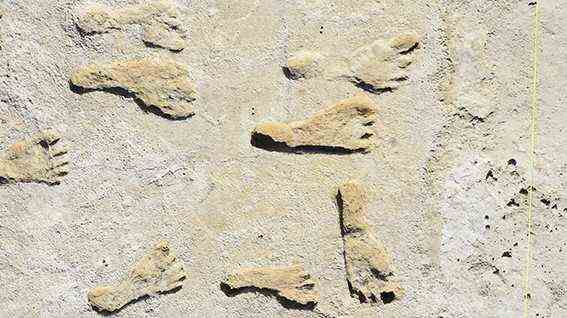23,000 to 21,000 years ago, people trudged through the mud, alone and in small groups, on a lakeshore in what is now New Mexico, leaving their footprints. At least that is the conclusion of a new study that archaeologist Loren Davis of Oregon State University in Corvallis describes as “potentially groundbreaking.” If the data is correct, the discovery would be the strongest evidence yet that humans reached America in the middle of the last ice age, thousands of years earlier than many archaeologists thought.
“If that’s true, it will revolutionize the way we think about archeology in America,” says Davis, who was not involved in the work. It could rekindle the debate about how the first humans reached the continent from Asia. But Davis and others would like to see the surprising data corroborated before rewriting their understanding of when and how people came to the continent.
At the height of the last ice age around 26,500 to 19,000 years ago, a land bridge connected Russia and Alaska. In this way, people were able to colonize the Beringia region, which is now largely underwater. But glaciers covered large parts of Canada, blocking the way south to what is now the United States and beyond. Archaeologists initially assumed that the first humans reached America through a corridor that opened up between the glaciers about 13,500 years ago. Finds from several locations over the past few decades, however, indicate that humans were in America more than 16,000 years ago. This led to the assumption that the first to arrive bypassed the ice by taking a boat along the Pacific coast.
The footprints may come from young people who passed the time at the lake
A few references suggest an even older date, but these findings are controversial. So was last year in one Nature– Article claims that humans left artifacts in a cave in the highlands of Zacatecas, Mexico at least 27,000 years ago. But many archaeologists doubt that the broken rocks are actually stone tools.
Footprints are “a whole different level of evidence,” says Ciprian Ardelean, an archaeologist at the Autonomous University of Zacatecas who discovered the cave. “Human footprints on the ground are undeniable.”
Years of field research in New Mexico’s White Sands National Park have uncovered thousands of footprints left by humans and animals, including extinct mammoths and sloths, in a now dry lake bed. In the new study in the trade journal Science it’s about 60 human footprints from seven layers of sediment. Michael Bennett, an expert on ancient footprints at Bournemouth University, compares the findings with a page of parchment that is regularly rewritten, suggesting “people who have walked over a long period of time”. Given the size of the prints, he believes that most of them were left behind by teenagers and children who might fetch water or just pass the time. “People spend a lot of time playing games. And where better to play than at the edge of a lake?” Says Daniel Odess, an archaeologist with the US National Park Administration.
“There’s no doubt that they’re human footprints,” says Kevin Hatala, an ancient footprint expert at Chatham University. The only question is: how old are you exactly? To find out, the researchers used the radiocarbon dating method to date seeds embedded in several layers of earth between the footprints. According to this, the Sami are between 23,000 and 21,000 years old and thus fall at the height of the Ice Age glaciation. If the prints are that old too, people must have got to America before ice sheets blocked the way. So an early overland trip might have been possible.
“We have tried again and again to refute our own results,” says Odess. For example, the researchers checked whether the chemical composition of the old seawater could have falsified the data. But again and again you got the result: “Yes, they are really that old.”
Oregon State University’s Loren Davis points out another possibility, however: the seeds may be older than the footprints because they may have eroded from older sediments and then sifted into the mud the team dug up. Perhaps luminescent dating could reveal when the sediment was spilled around the footprints, suggests Davis.
So far, the team has not found any artifacts that could reveal the culture of the people who made the footprints. According to Odess, however, White Sands underpins other traces of early American settlement. “With something so extraordinary, it would be nice if we had multiple lines of evidence,” says Liaocheng University archaeologist Ben Potter. But even if the evidence is not yet final: the finds in White Sands provided “strong arguments for a very early settlement”.
The original of this article is in the science magazine Science published by the AAAS. German version: cvei.

